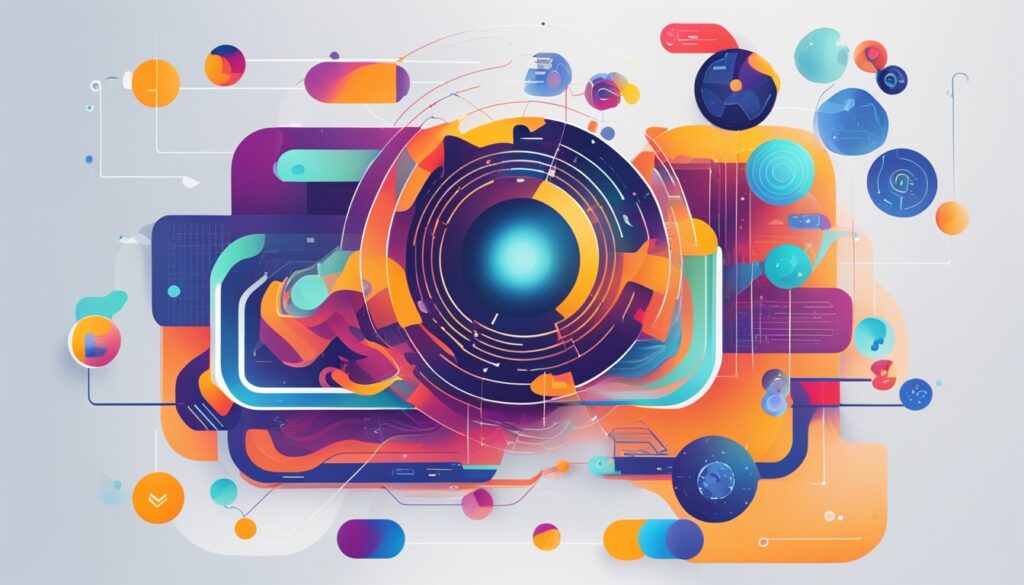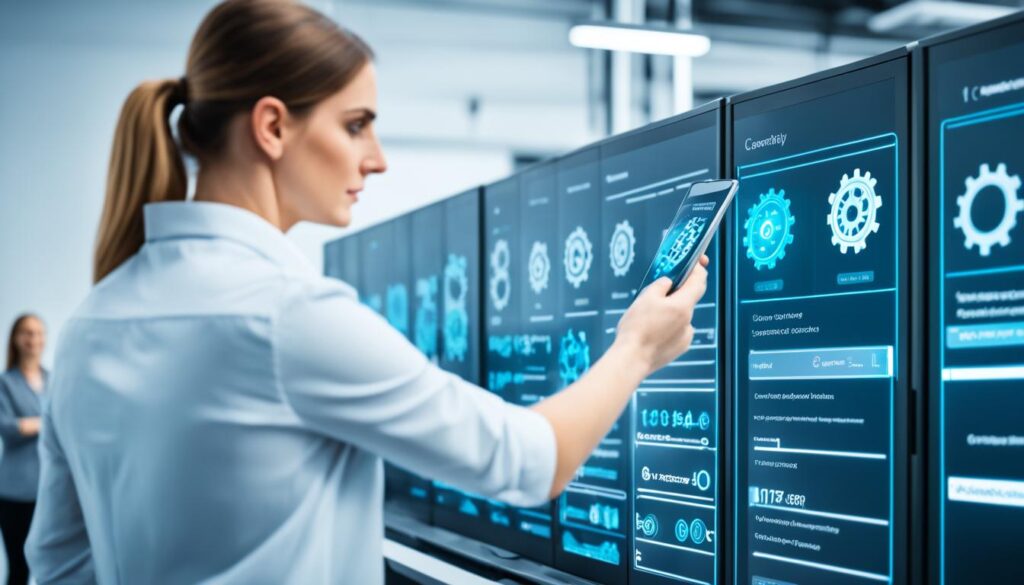In today’s fast-changing mobile world, adding AI and ML to mobile apps is key for businesses. It helps improve user experiences, bring new features, and stay ahead. This guide will show you how to use these advanced tools. You’ll learn to make AI-powered mobile applications with machine learning-driven app functionality.
Table of Contents
Key Takeaways
- Understand the potential of AI and ML in mobile app development
- Explore the benefits of integrating AI and ML into mobile apps
- Learn how to effectively integrate AI and ML frameworks into your mobile app
- Discover strategies for data collection, preparation, and model training
- Gain insights into seamless integration of AI/ML models into mobile apps
Introduction to AI and Machine Learning in Mobile Apps
The mobile app world has changed a lot with the help of Artificial Intelligence (AI) and Machine Learning. These technologies are changing how apps are made and used. They bring new chances for better user experiences, more personalized services, and smart automation.
Understanding the Potential of AI and ML
AI and ML can change the mobile app industry a lot. They can look at what users like and give them what they want. This makes apps more personal and fun. AI chatbots and virtual assistants also make customer support better, making apps more useful and engaging.
Benefits of Integrating AI and ML in Mobile Apps
- Increased user engagement and retention through personalized experiences
- Improved decision-making capabilities by using data-driven insights
- Enhanced operational efficiency through smart automation and task optimization
- Competitive differentiation by offering unique, AI-powered features and capabilities
- Continuous learning and adaptation to evolving user needs and market trends
Adding AI and ML to mobile apps opens up new possibilities. It makes apps better and improves how users feel. These technologies are leading to a future where apps are smarter, more adaptable, and meet user needs better. This changes how we use our digital devices.
How to Integrate AI and Machine Learning
Adding AI and machine learning (ML) to mobile apps can make them more innovative and improve how users experience them. The process of integrating AI and ML has several key steps. These include picking the right use cases and choosing the best frameworks and techniques for easy use.
First, developers need to look at where AI and ML can help their app. They should check the data, find out what users struggle with, and think about how smart features could make the app better. By incorporating AI and ML technologies wisely, apps can become more tailored, smart, and user-friendly.
- Define the AI/ML use cases: Find out where AI and ML can make a big difference in the app, like with predictive analytics or natural language processing.
- Evaluate AI/ML frameworks and tools: Look at different AI and ML integration strategies like open-source frameworks, cloud services, and custom models to see what works best for your app.
- Collect and prepare data: Make sure the app has good, relevant data for training and improving the AI/ML models. This might mean collecting, cleaning, and getting the data ready.
- Implement and integrate the AI/ML models: Put the chosen AI/ML models into the app in a way that works well with the app’s main features.
- Test and iterate: Keep testing the AI/ML features, watch how they do, and make changes to get the best results for users and the business.
By following a clear process of integrating AI and ML into mobile apps, developers can open up new possibilities. They can make the user experience smarter, more adaptable, and more personal.
| Key Steps in AI/ML Integration | Description |
|---|---|
| Define the AI/ML use cases | Find out where AI and ML can solve problems or improve things in the app. |
| Evaluate AI/ML frameworks and tools | Look at different AI and ML strategies, including open-source and cloud options. |
| Collect and prepare data | Make sure the app has the right data for the AI/ML models. |
| Implement and integrate the AI/ML models | Put the AI/ML models into the app in a way that fits well with everything else. |
| Test and iterate | Keep testing the AI/ML features, check how they’re doing, and make changes to get the best results. |
“Integrating AI and machine learning into mobile apps is a transformative process that can unlock new possibilities and elevate the user experience.”
Selecting the Right AI/ML Framework
Choosing the right AI and machine learning (AI/ML) framework is key for mobile apps. The framework you pick can greatly affect your app’s performance and success. Top choices include TensorFlow Lite, Core ML, and Amazon SageMaker, each with special features.
Evaluating AI/ML Frameworks
When looking at AI/ML frameworks for mobile apps, think about these important factors:
- Make sure the framework works well with your app’s operating system, like Android or iOS.
- Check how easy it is to deploy and run AI/ML models on the device. Consider the model size and how fast it works.
- Look for open-source tools and libraries that can make development easier and more flexible.
- Consider commercial platforms that offer full AI/ML services, like data processing and model training.
- See if the framework can handle complex tasks and grow with your app as it gets more users and data.
Choosing the right AI/ML framework lets mobile app developers make apps that are smart, innovative, and easy to use.
| AI/ML Framework | Key Features | Supported Platforms |
|---|---|---|
| TensorFlow Lite | – Optimized for mobile and edge devices – Supports a wide range of AI/ML models – Includes tools for model conversion and deployment |
Android, iOS |
| Core ML | – Developed by Apple for iOS devices – Integrates well with Apple’s ecosystem – Offers efficient on-device processing |
iOS |
| Amazon SageMaker | – Comprehensive AI/ML platform – Includes tools for data preparation, model training, and deployment – Supports multiple cloud and on-premises environments |
Cross-platform |
By carefully checking out these and other AI/ML frameworks, developers can pick the best one for their project. This ensures a successful use of AI and machine learning in their apps.
Data Collection and Preparation
For AI and machine learning in mobile apps, having good data is key. It’s important to collect and clean high-quality data. This makes sure the AI/ML models work well and give accurate results.
Sourcing and Cleaning Data for AI/ML Models
Creating a strong data requirements for AI/ML takes a few steps:
- Finding data collection for mobile app AI and ML sources, both inside and outside the app, that have the right info.
- Using data preprocessing and cleaning to make sure the data is good and consistent.
- Fixing data quality for AI/ML models problems like missing data or weird values.
- Creating data management strategies to keep the AI/ML data up to date and improving it.
| Data Type | Examples | Relevance for AI/ML |
|---|---|---|
| Structured Data | User profiles, transaction records, sensor data | Provides a clear, organized foundation for AI/ML models. |
| Unstructured Data | Customer reviews, social media posts, images, audio files | Offers valuable insights and context, but requires more preprocessing. |
| Semi-structured Data | Email conversations, support tickets, IoT device logs | Combines the benefits of structured and unstructured data. |
By picking and cleaning the data carefully, app developers can make sure the data quality for AI/ML models is top-notch. This sets a solid base for successful AI and machine learning use.
“Garbage in, garbage out – the quality of machine learning models is entirely dependent on the quality of the data used to train them.”
Training and Deploying AI/ML Models
Adding AI and ML to mobile apps is a big task that needs careful planning. A key part is training and deploying AI/ML models. This means making the models work better, fine-tuning them, and putting them into the app smoothly.
Mastering Model Training
Training AI/ML models is a detailed process. Developers need to know the algorithms and data well. They must pick the right training methods, like supervised or unsupervised learning, for the app’s needs. Also, the training data should be right, showing what the app will face in real life.
Optimizing Model Performance
After training, it’s time to make the models work better. This means doing things like adjusting settings, making the models smaller, and changing them for faster work. Spending time on this makes sure the models give accurate and quick results, making the app better for users.
Deploying and Integrating AI/ML Models
The last step is to put the trained and improved AI/ML models into the app. This might mean exporting models, changing them for the app, and managing them well. Developers should think about keeping track of model versions, caching, and offline use for a smooth integration.
| Approach | Description | Benefits |
|---|---|---|
| On-device model deployment | Running the AI/ML models directly on the user’s device, rather than relying on a cloud-based infrastructure | Improved privacy, reduced latency, and offline functionality |
| Cloud-based model deployment | Hosting the AI/ML models on a remote server and accessing them through the mobile app | Easier model updates, scalability, and access to greater computing resources |
By getting good at training, optimizing, and deploying AI/ML models, app developers can make the most of these technologies. This leads to smarter and quicker experiences for users.
“The true power of AI lies in its ability to transform the way we interact with technology. By seamlessly integrating AI/ML models into mobile apps, developers can create experiences that are both intelligent and intuitive.”
Integrating AI/ML Models into Mobile Apps
It’s key to blend AI and machine learning smoothly into mobile apps for a great user experience. Developers need to pick the right methods and approaches. This ensures a smooth and efficient use of these advanced features.
Techniques for Seamless Integration
One top way to add AI/ML models to mobile apps is through API integration. Using pre-built AI services and APIs lets developers quickly add AI and ML capabilities to their apps. This method is scalable and gives access to the latest tech.
Another method is SDK integration. Here, developers use special AI/ML software development kits in their apps. This gives more control and lets developers customize the AI/ML features for their needs.
- Use pre-built AI services and APIs for fast and efficient integrating AI/ML models
- Choose specialized AI/ML SDKs for more customization and control over embedding AI and ML capabilities
- Make sure the user experience is smooth and responsive by using the right techniques for AI/ML integration
By using these methods, developers can add AI/ML models to their apps well. This brings new and smart user experiences powered by artificial intelligence and machine learning.
Use Cases of AI and Machine Learning in Mobile Apps
AI and machine learning (ML) have changed how we use our smartphones. They bring personalized experiences and smart automation to mobile apps. Let’s look at how AI and ML are making a big impact in mobile apps today.
Personalized Experiences and Recommendations
Apps like Netflix, Spotify, and Amazon use AI to change how we find and enjoy. They use ML to understand what we like and suggest things we might enjoy. This makes using these apps more fun and keeps us coming back for more.
Intelligent Automation and Productivity
AI and ML help automate tasks in mobile apps too. Evernote, for example, uses AI to sort and organize our notes. This saves us time and makes us more productive. Apps like Siri, Google Assistant, and Alexa use AI to understand what we say and help us out with tasks.
| Mobile App | AI/ML Use Case | Key Benefits |
|---|---|---|
| Netflix | Personalized content recommendations | Increased user engagement and retention |
| Evernote | Automated note organization and categorization | Improved productivity and time-saving |
| Siri | Natural language processing and virtual assistance | Enhanced user experience and convenience |
These examples show how AI and ML are changing mobile apps. They offer personalized experiences, smart automation, and new solutions for users.
“The integration of AI and machine learning in mobile apps is not just a trend, but a strategic imperative for businesses looking to stay ahead in the digital landscape.”
User Experience Considerations
Adding AI and machine learning to mobile apps needs a focus on user experience (UX). It’s key to make intuitive AI/ML interfaces to improve how users interact with apps. By putting users first when adding AI and ML, developers can make sure the experience is smooth and enjoyable.
Creating intuitive AI/ML interfaces means focusing on easy and natural ways to interact. Using techniques like natural language processing, apps can give users personalized experiences. This makes the app more useful and fun for everyone.
It’s also important to think about ethics in user experience design for AI/ML-powered apps. Keeping user data safe, being clear about how AI works, and fixing biases are key. By doing this, developers can make apps that use AI and ML well and meet what users want and expect.
| Key Considerations for Enhancing Mobile App UX with AI and ML |
|---|
|
“Integrating AI and machine learning into mobile apps is not just about leveraging the technology, but also about designing intuitive experiences that put the user first.”
Privacy and Security Concerns
AI and machine learning are becoming more common in mobile apps. It’s important to focus on privacy and security. App developers and businesses must protect user data and follow the law. We’ll look at how to keep sensitive info safe in AI/ML apps.
Prioritizing Data Protection
Keeping AI and ML models safe is key to keeping users trusting and following the law. Developers should use strong encryption, secure storage, and anonymize data. They should also regularly check for security threats.
Adhering to Regulatory Compliance
Following the law is vital when using AI and machine learning in apps. Developers need to know about laws like GDPR and HIPAA, based on their app’s data handling. Adding compliance steps early in app development is important to avoid legal trouble.
Implementing Best Practices for User Data Security
- Get clear user consent for data use
- Use multi-factor authentication for accounts
- Keep an eye on app permissions and data access
- Have clear data storage policies and let users delete their data
- Keep the app updated to fix security issues
By focusing on privacy and security, and using best practices, app developers can gain trust. They can also follow the law and use AI and machine learning responsibly in their apps.
Testing and Monitoring AI/ML Models
Adding AI and machine learning to mobile apps needs a strong testing and monitoring plan. This ensures the tech works well and accurately. It’s key to test AI/ML models well to check how they perform and spot problems early.
Keeping an eye on AI/ML model performance is also crucial. Developers can see how the models act and tweak them as needed. This keeps the quality assurance high in mobile apps and keeps the models current and useful.
Strategies for Effective Testing and Monitoring
- Use detailed testing protocols to check the AI/ML models’ accuracy, reliability, and strength.
- Set up benchmarking techniques to see how the models stack up against certain standards.
- Build monitoring frameworks to watch the models, spot oddities, and alert for problems.
- Regularly validate and refine the AI/ML models to keep them in line with user needs and data changes.
| Testing Technique | Purpose | Key Considerations |
|---|---|---|
| Unit Testing | Make sure each part of the AI/ML models works right | Make sure the models handle all kinds of inputs and edge cases |
| Integration Testing | Check how the AI/ML models fit into the app’s setup | Look at the full performance and data flow of the models and the app |
| Performance Testing | See how the AI/ML models do under different loads | Make the models work well for real use and on mobile devices |
With strong testing and monitoring strategies, mobile app makers can make sure their AI and ML features are top-notch. This means users get reliable and precise experiences.
Continuous Learning and Model Updates
In the fast-changing world of mobile apps, keeping AI and machine learning models up to date is key. As users’ needs and market trends shift, developers must keep learning and updating their AI/ML models. This keeps their apps relevant and responsive.
Strategies for Keeping AI/ML Models Fresh
For continuous learning and model updates, a detailed approach is needed. Here are some important strategies:
- Ongoing Data Collection: Gather new user data and insights regularly to understand changing needs and patterns.
- Periodic Retraining: Update AI/ML models often with the latest data to match user preferences and behaviors.
- Automated Model Updates: Use automated processes to easily update AI/ML models, ensuring smooth integration with little disruption.
- Proactive Monitoring: Watch the performance and accuracy of AI/ML models closely. Fix any issues quickly to keep them working well.
- Iterative Refinement: Improve and fine-tune AI/ML models with user feedback and changing business needs.
By using these strategies for continuous learning for AI/ML models, updating AI/ML models, and maintaining AI and ML model relevance, developers can keep their apps leading-edge and give users great experiences.
| Strategies | Description |
|---|---|
| Ongoing Data Collection | Keep gathering new user data and insights to understand changing needs and patterns. |
| Periodic Retraining | Update AI/ML models regularly with new data to keep up with user preferences and behaviors. |
| Automated Model Updates | Use automated processes to make updating AI/ML models easy, ensuring a smooth transition for users. |
| Proactive Monitoring | Keep a close eye on how well AI/ML models perform and fix any problems quickly. |
| Iterative Refinement | Always improve and fine-tune AI/ML models based on user feedback and new business needs. |
By using these strategies for model updates and refinement, developers can keep their mobile apps at the cutting edge. They ensure great user experiences.
“Continuous learning and model updates are key to keeping AI-powered mobile apps competitive in today’s fast-changing market.”
Emerging Trends in AI and Machine Learning for Mobile Apps
The mobile app world is changing fast, and AI and ML are key to this change. These technologies are set to change the game in mobile app development. They promise new use cases and advancements that will shape the future.
Intelligent personal assistants are becoming more common. They use AI and natural language to make interacting with our phones easy, just by talking. These assistants can schedule meetings and remind you of things, changing how we use our phones.
Computer vision and image recognition are also making their mark in mobile apps. For example, augmented reality apps mix the real and virtual worlds. This lets users see and interact with new kinds of content on their phones.
- Advances in mobile AI and ML are making apps more personal and relevant.
- AI-powered predictive analytics and recommendation engines can guess what users want and like.
- Federated learning is a big step forward, training AI models on phones without sharing personal info.
The mobile app world is really taking off with AI and ML. We’ll see more new ways these technologies change how we use our phones and see the world.
| Emerging Trend | Description | Potential Impact |
|---|---|---|
| Intelligent Personal Assistants | AI-powered virtual assistants that can handle a variety of tasks through natural language interactions | Improved productivity, personalized experiences, and seamless interaction with mobile devices |
| Computer Vision and AR | Integration of computer vision and image recognition capabilities to enable augmented reality experiences | Immersive and interactive mobile apps that blend digital and physical worlds |
| Personalized and Contextual Experiences | Advancements in mobile AI and ML to provide more personalized and contextual app experiences | Increased user engagement, loyalty, and satisfaction |
The mobile app industry is embracing emerging AI and ML trends. This is opening up a new era of innovative AI/ML use cases and advancements in mobile AI and ML technologies.
“The future of mobile apps lies in the seamless integration of AI and machine learning, empowering users with intelligent, personalized, and immersive experiences.”
Challenges and Limitations
Integrating AI and machine learning in mobile apps is promising but comes with challenges. Technical issues, data availability, and regulatory hurdles make it tough. These obstacles need to be overcome for successful AI/ML integration in mobile app development.
Overcoming Obstacles in AI/ML Integration
One big challenge is the technical complexity. Adding AI and machine learning to mobile apps is tricky. Developers must think about model size, how fast it works, and how it affects the battery. They need to make the models work well on mobile devices without slowing them down.
Another issue is getting enough good data. Mobile apps often have limited data that’s not diverse enough for AI/ML models. To fix this, developers must find new ways to collect and prepare data.
Then, there are rules about data privacy and security. These rules make it hard to use AI/ML in apps. Developers must make sure their apps protect user data and follow the rules.
To beat these challenges, app teams need a strong plan. They should work with AI/ML experts, use pre-trained models, and try new methods like federated learning. By tackling these issues, developers can make the most of AI and machine learning in their apps.
Resources and Tools for AI/ML Mobile App Development
Adding artificial intelligence (AI) and machine learning (ML) to mobile apps can make them better and open up new possibilities. We’ve put together a list of resources and tools to help you in this exciting field. These tools can guide you through the AI/ML world for mobile app development.
Educational Materials
- Udacity’s Intro to Artificial Intelligence for Mobile Nanodegree program
- Coursera’s Machine Learning for Mobile iOS and Android Apps course
- Pluralsight’s Developing AI-Powered Mobile Apps learning path
- Google’s Machine Learning Crash Course – free online training
Industry-Leading Platforms and Frameworks
| Platform | Description |
|---|---|
| TensorFlow Lite | A lightweight version of the TensorFlow machine learning framework, optimized for mobile and edge devices. |
| Core ML | Apple’s framework for integrating machine learning models into iOS, iPadOS, and macOS apps. |
| Amazon SageMaker | A fully managed machine learning service from AWS, with tools for building, training, and deploying models. |
| Google ML Kit | A suite of AI/ML APIs from Google, designed to bring powerful machine learning capabilities to mobile apps. |
These resources and tools can help you explore the possibilities and learn more. They also let you use top platforms and frameworks for adding resources for AI/ML in mobile apps, tools for AI and ML integration, and educational materials for AI/ML in mobile development to your apps.
“Integrating AI and machine learning into mobile apps is no longer a luxury, but a necessity to stay competitive and offer enhanced user experiences.”
Conclusion
Throughout this article, we’ve seen how AI and machine learning change mobile app development. These technologies make apps better, more useful, and more successful. They help developers improve the app’s features and how users experience them.
AI and machine learning offer many chances, like personalized suggestions and smarter decision-making. By using these tools, app developers can make their apps stand out. This helps them win in a busy market.
Looking ahead, AI and machine learning will keep changing the mobile app world. Developers who keep up with new trends and methods will use these tools well. This can lead to more customer interaction, better work processes, and the success of their apps over time.















